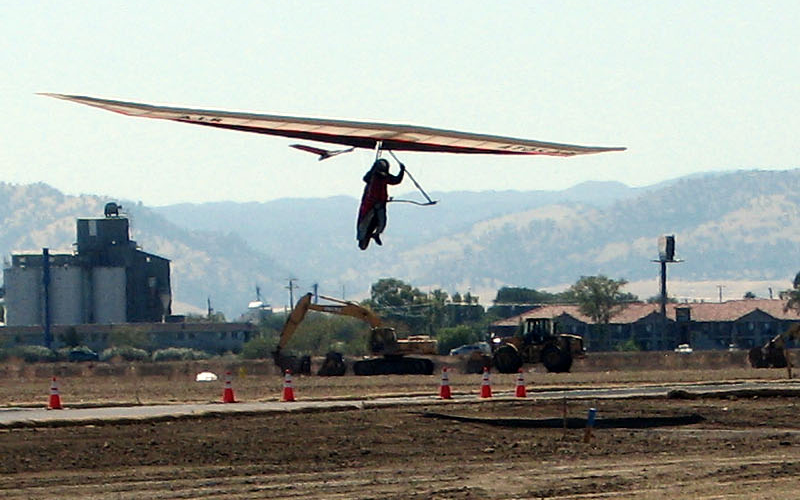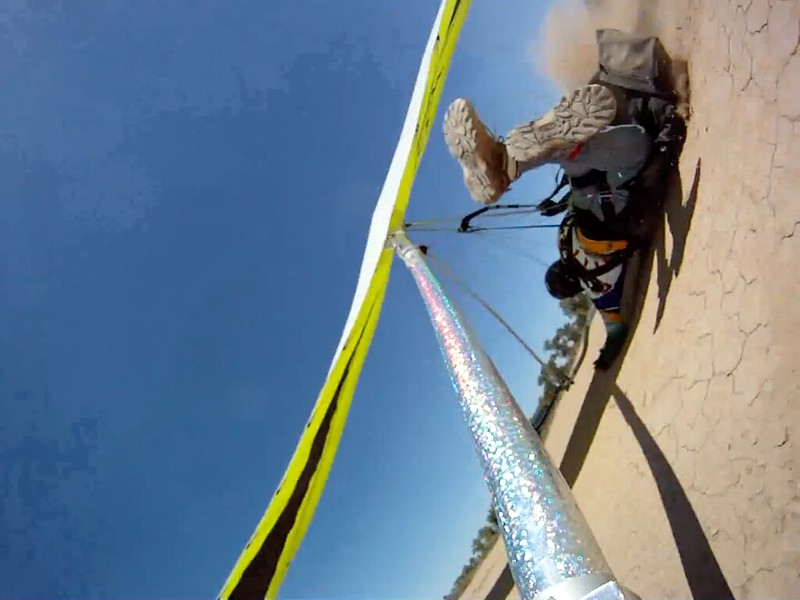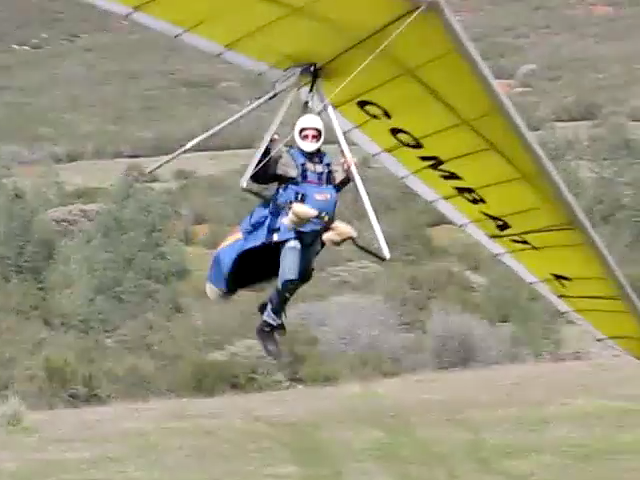http://www.hanggliding.org/viewtopic.php?t=30163
Landing Approaches on Restricted Landing Fields?
Steve Seibel - 2013/10/24 01:22:30 UTC
slipping turn challenge / new thread
Re 2 posts above-- I have a response but I do not want to hijack a practical flying thread. If what you say is full assessment of the situation though, you should be able to put the glider in a 45 degree bank at the min sink angle-of-attack, then smoothly and steadily pull in the bar over a 5-second interval, causing a steady acceleration over those 5 seconds. As long as the glider is accelerating, weight is not fully supported by either lift or drag. So by your assessment, if I understand, the yaw strings should blow markedly sideways as the glider falls through the air, falling earthward under gravity's pull.
If so you can film this and win the "slipping turn challenge". I will eat humble pie and buy you a beer.
HANG ON I will re-post this content in a new thread so we do not trample on the restricted landing thread any further. Because this will turn into a physics discussion.
New thread:
http://www.hanggliding.org/viewtopic.php?t=30177
Slipping turn challenge/ discussion
If we want to take the short hand that we will call a diving turn a slipping turn, that's one thing, but the comments above seemed to be going further than that.
Yeah Steve, I was pretty confident you'd turn up here with this. And I've skimmed your stuff before and I'll happily defer to you.
But...
If I come over the treeline, pull in, and roll hard I'm doing the opposite of what I'd wanna do to maximize my glide and time in the air. I'm dumping energy I'm not gonna get back.
And then I'll level the glider - and I'm gonna have a crisp response 'cause I've got a lot of speed - then wait until it's starting to feel like not flying any more.
Tim Ward - 2013/10/24 13:49:11 UTC
From a practical point of view, whether you call it a slipping turn, a diving turn, or a recovery from a semi-stalled turn, it's not often useful for tight LZs, because while it does lose altitude, it doesn't lose much energy. You wind up rocketing along near the ground needing to slow down before you hit the other side.
Within a half span or so of the ground, you're in ground effect, and so you're not losing energy as fast as you would when higher.
If it's that tight it's not an LZ - it's a FIELD. And it's a field you shouldn't have come into. And if you're gonna come into fields that tight then toss a drag chute.
Paul Edwards - 2013/10/24 19:16:47 UTC
I'm not really qualified to comment here as I am a total wimp about low turns.
You just made a valuable comment. Being a total wimp about low turns is an excellent disqualification for being able to handle tight landing situations.
NMERider - 2013/10/22 06:42:04 UTC
Make every landing an RLF landing even if it's in a great big flat field full of streamers. Set up the scenario in your mind before you get low and then execute your plan when you do land and if it were and RLF. Pilots bug me about flying XC and almost never treat their local landings as mock RLFs. You can practice and improve your crisis situation skills in safe environments. Failure to do this on a regular basis lowers your odds of survival in critical XC flying.
I love DBF approaches with long high finals.
I never had the slightest doubt.
Stay close to a field that's big enough I say.
And never use it as an exercise to enhance your ability to handle a tight field. You certainly wouldn't want to raise your odds of survival in a critical XC situation.
However I did witness a pilot flying a Pulse turn tight 360s all the way to the deck, then level out with just enough speed to glide a short ways and flare. He landed it right on the frikkin cone. It was a couple of years ago but if memory serves the whole approach could have fit into a 75 foot diameter circle.
Memory does not serve.
Too risky for my taste, but it's good to see what's possible sometimes.
Very little is gonna be possible if you don't practice anything. You don't hafta duplicate what you saw - just do a mild version of the same thing and keep pushing your comfort level a little each time.
Jason Boehm - 2013/10/24 19:39:37 UTC
75 feet or 75 yards?
Yards. And that would hafta be the radius - not the diameter.
Paul Edwards - 2013/10/24 19:47:23 UTC
I mean feet, but I really can't back the number up.
No. You can't. Because for the glider to be turning inside of a 75 foot diameter circle the inside wingtip would hafta be nearly stationary.
What I remember the most is how astonished I was at how narrow the whole pattern was. Before that evening I would have said it was impossible. It couldn't have been more than 100 feet from where he rounded out to where his feet touched earth.
But don't experiment any and work your way up a bit towards what he was doing. Just assume that you're never gonna hafta land in anything tighter than the Lockout Mountain Happy Acres putting green.
And keep working on your flare timing. You never know when somebody's gonna come in and strew large rocks all over the place.
Jonathan Boarini - 2013/10/24 19:49:52 UTC
Miami
I always come in on final with plenty of speed. But I do wonder, would it be a valid tactic to come in slow to avoid overshooting and hitting a hazardous obstacle? Has anybody ever done this in a RLF? My thinking is that by coming in slow on final you have less energy and maybe in certain cases mushing in and pounding into the ground might be preferable to hitting say, powerlines on the other side.
NMERider - 2013/10/24 20:03:27 UTC
It is very irresponsible advice to suggest to newer pilots that it is ever o.k. to come in to an RLF situation with low airspeed without going into details of the ramifications of hitting turbulence or a gradient, etc.
Or...
http://www.flyatos.com/bill_landing.jpg

...suddenly finding yourself looking at powerlines straight ahead and not having the maneuvering speed you need to be able to survive the situation.
It's a good way to lead someone who is naive into the morgue or the ER.
1. Shouldn't his USHGA certified instructor schooled him enough in the basics to make him invulnerable to crap advice?
2. Yeah... So's THIS:
http://ozreport.com/forum/viewtopic.php?t=30971
Zach Marzec
NMERider - 2013/02/19 22:56:19 UTC
I will appreciate that it is the tug pilot's call as to the maximum breaking strength of any so-called weak link system and not mine.
But you're not gonna get in any trouble with anyone for speaking out against newer pilots using low airspeed on landing approaches.






 That way when a weak link breaks on you, ITS A NON-ISSUE. Genius huh???
That way when a weak link breaks on you, ITS A NON-ISSUE. Genius huh???